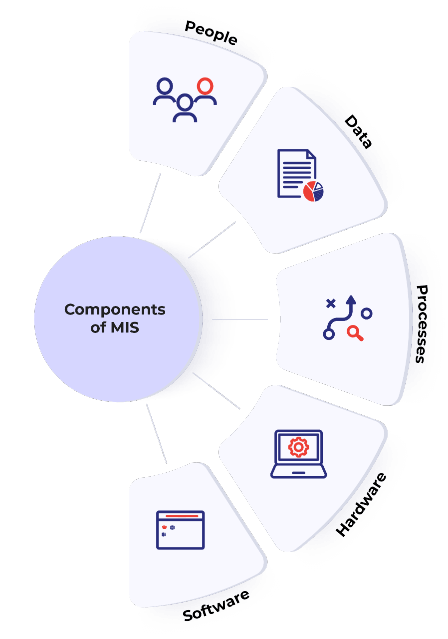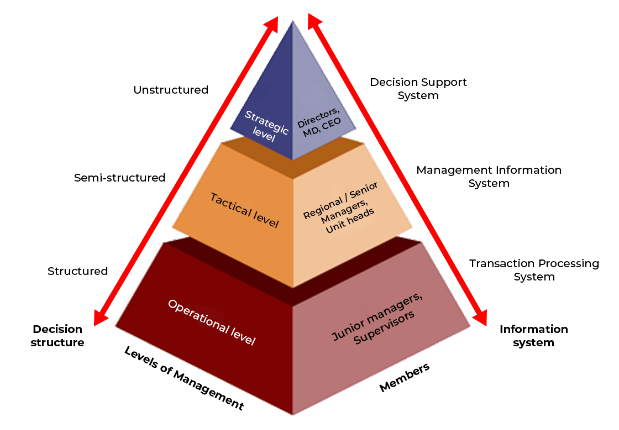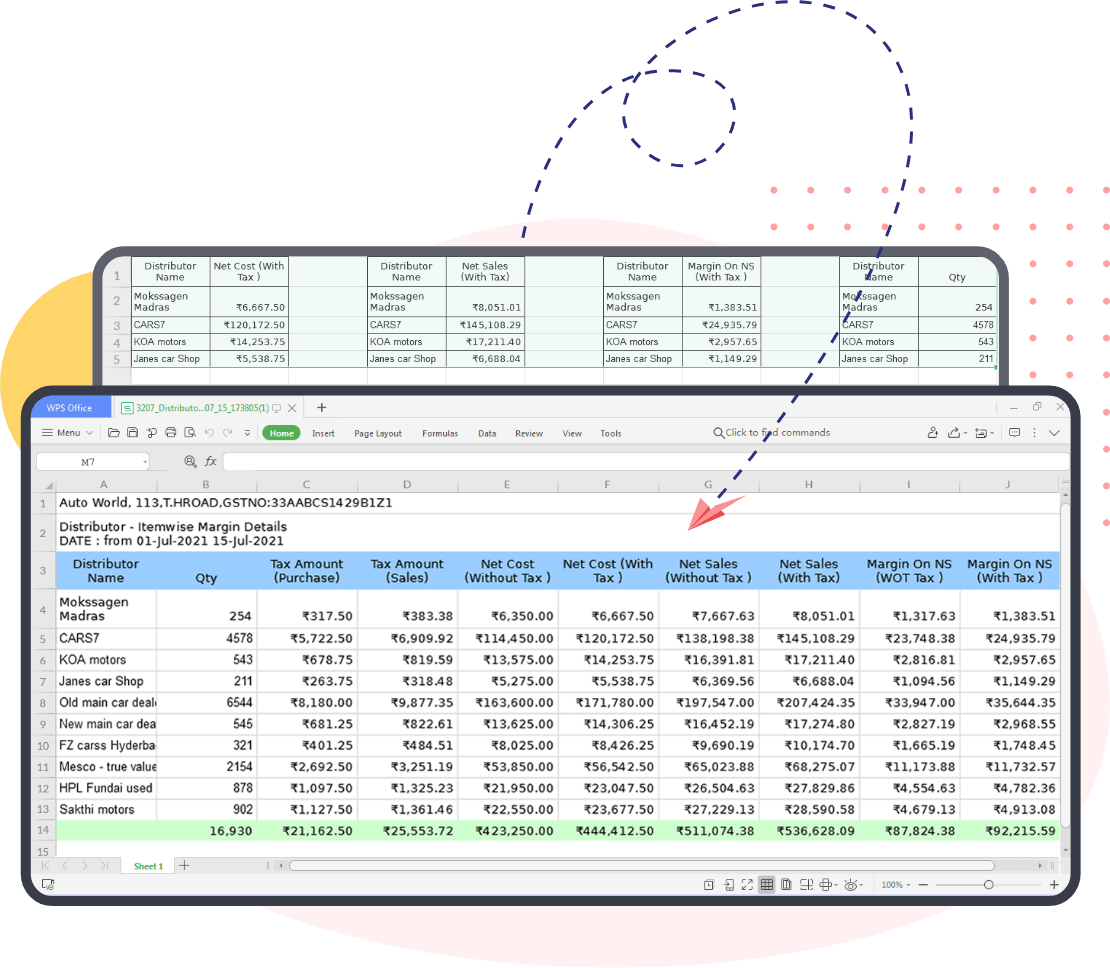Everything you
need to know about
MIS Reports
Everything you need to know about MIS Reports
What is an MIS report?
MIS stands for management information system, and an MIS report is a summary that visualizes how well a company performs, using the information/reports from multiple departments for data-driven decision-making. MIS reports are specifically tailored to meet the unique needs of a business and are generated quickly to offer valuable insights that are easily accessible from any location.
Businesses can effortlessly analyze critical data and make informed decisions by selecting the appropriate type of MIS report. Typically, MIS reports are prepared at regular intervals (daily, weekly, monthly, or quarterly) depending on the business requirements to ensure smooth operations. For businesses seeking MIS reports to improve efficiency, opting for an automated MIS reporting system can streamline the process of collecting, processing, and presenting data in the desired format.
How to create an MIS report in 6 simple steps
Generating a Management Information System (MIS) reports involves several milestones from defining a purpose, collecting data, processing it, and converting it into a presentable format. Based on the business requirements, the decision maker who is generating the MIS report can decide the format they need by customizing the steps. Here's a short glimpse of the steps involved in MIS report generation.
Define purpose
Decide the purpose of the report first, so its focus gets narrowed down to the aspect that is required for the decision-making.
1
Collect data
Collect the data that is required to arrive at a report from the relevant sources of the organization. The data should be accurate and complete.
2
Process data
The data collected is raw data. Process the data by cleaning it and converting it into a standardized format to gather some insights from it.
3
Analyze data
The processed data can now provide insights and analysis of the aspect that is being analyzed. List down the insights interpreted.
4
Format data
Shape the data and its insights into a presentable format using any report layout structure or graphical representations.
5
Take decisions
Using the MIS reports prepared, management can review the MIS reports, assess the organization's status, and make informed decisions.
6
Why do organizations need MIS reports?
Convert data to insights
The major purpose of an MIS report in a business is to derive actionable insights from the available data. Converting data into actionable insights based on business requirements is the key feature of MIS reports. Below is an example of an MIS report that demonstrates how this works:
The raw data shows that our supermarket, with over 750 types of items on the shelves, generated sales of Rs. 30 lakhs for the month. An insight drawn from this data is that 75% of the sales came from the grocery and healthcare sections. Based on this insight, a manager can make a profitable decision: allocate an additional 25% of the budget to purchase these fast-selling products.
This is how an MIS report functions. It’s not limited to purchase decisions; the MIS reporting system can be implemented across all departments.
Predict the future
In addition to helping businesses make informed decisions, an MIS report can also be used to predict future trends. When data is pooled, we can see a pattern emerge.
For example, a spike in sunscreen lotion sales from the healthcare section during the last week of April can reveal important insights.
With this information, businesses can make a variety of decisions, such as planning next month’s inventory, identifying key brands to focus on, managing small expenses, and evaluating larger investment opportunities.
An effective MIS report also allows you to predict cash flow, optimize resource allocation, and maintain control over your bottom line, ultimately boosting profitability.
By leveraging MIS reports for predictive analysis, businesses can stay ahead of market trends, improve operational efficiency, and drive long-term success.
Communicate clearly across company divisions
Preparing MIS report ensures timely decision-making. Each level of management demands a different set of insights that can be interpreted from various types of MIS reports. Day-to-day sales till employee attrition rate has to be communicated to different levels of management. The outstanding credit amount to be collected from customers has to be constantly notified to them, once the credit period is exceeded. Similarly, MIS report for manufacturing company will be totally different and it includes data as per their need. With various types of MIS reports available, these insights could be derived for faster decision-making.
The major purpose of an MIS report in a business is to derive actionable insights from the available data. Converting data into actionable insights based on business requirements is the key feature of MIS reports. Below is an example of an MIS report that demonstrates how this works:
The raw data shows that our supermarket, with over 750 types of items on the shelves, generated sales of Rs. 30 lakhs for the month. An insight drawn from this data is that 75% of the sales came from the grocery and healthcare sections. Based on this insight, a manager can make a profitable decision: allocate an additional 25% of the budget to purchase these fast-selling products.
This is how an MIS report functions. It’s not limited to purchase decisions; the MIS reporting system can be implemented across all departments.
In addition to helping businesses make informed decisions, an MIS report can also be used to predict future trends. When data is pooled, we can see a pattern emerge.
For example, a spike in sunscreen lotion sales from the healthcare section during the last week of April can reveal important insights.
With this information, businesses can make a variety of decisions, such as planning next month’s inventory, identifying key brands to focus on, managing small expenses, and evaluating larger investment opportunities.
An effective MIS report also allows you to predict cash flow, optimize resource allocation, and maintain control over your bottom line, ultimately boosting profitability.
By leveraging MIS reports for predictive analysis, businesses can stay ahead of market trends, improve operational efficiency, and drive long-term success.
Preparing MIS report ensures timely decision-making. Each level of management demands a different set of insights that can be interpreted from various types of MIS reports. Day-to-day sales till employee attrition rate has to be communicated to different levels of management. The outstanding credit amount to be collected from customers has to be constantly notified to them, once the credit period is exceeded. Similarly, MIS report for manufacturing company will be totally different and it includes data as per their need. With various types of MIS reports available, these insights could be derived for faster decision-making.
Why should you choose Gofrugal for creating MIS reports?
Here are three summarized reasons why the Gofrugal MIS report format is preferred over other formats.
Almost all types of MIS report formats for sales, inventory, and financials can be readily exported and easily shared
MIS reports can be accessed anytime, anywhere, from browsers to mobile devices
Certain MIS reports need to be sent to management daily or on specific days. Gofrugal handles this by allowing one-time scheduling of daily and monthly MIS reports. Simply provide the email addresses, dates, and times, and the MIS reports will be automatically sent as required.
Discover how our auto MIS report generation benefits customers

Generating MIS reports with 1 click has reduced our efforts, time, and resources. We were able to track every report right from received goods to financial statements anytime from anywhere. This helped us to make the right decisions at the right time and track our employee activities without any additional effort.
Examples of MIS Reports
MIS reports cater to various needs based on the aspect of the business being analyzed by the respective stakeholders. Few of MIS reports examples are as follows:
Customer-wise/product-wise sales reports with/without gross margin
Quadrant reports based on Item wise High-Low Profitability-Popularity combo
Financial Reports like Balance Sheet, Profit & Loss, Cash Flow, Fund flow statements
Expired stock / Non-Moving / Slow-Moving stock reports
Sales rep wise order in-take, sales, and collection reports
Exception reports like Negative balance/outstanding
Inventory / Debtors / Suppliers Ageing reports
Accounting Ratio reports
Audit Trail reports

What is a MIS Report?
An MIS report, which stands for Management Information System report, serves as a crucial tool that provides a comprehensive overview of an organization's performance. MIS reports include in-depth analyses of key factors such as sales, revenue, market trends, and challenges. Management information reports empower businesses to make informed decisions and execute their strategies more effectively. While the specific requirements may vary between businesses, manually creating MIS reports can be a time-consuming process. Fortunately, the utilization of reliable MIS reporting software streamlines the generation of these critical insights, facilitating quicker decision-making. Discover how MIS reports can enhance your organization's efficiency and propel it toward greater success.
MIS Report full form
"Management Information System Reports" is the full form of MIS Report. This report encompasses management, its information, and the various systems associated with it. Understanding the full form of MIS Report is essential for those seeking comprehensive insights into how management information systems contribute to effective decision-making and organizational operations to understand the full form of the MIS Report.
What is the Meaning of MIS Reports?
The MIS reports, also known as Management Information System report, are tailored for specific timeframes and intended for particular decision-makers. MIS Reports are structured and organized summaries of data and information that provide insights into various aspects of an organization's operations, performance, and management. MIS report helps in taking accurate and faster decision-making, process implementation, and achieving excellence in operations.

How do MIS reports work?
MIS reporting provides an overall view of a company's activities, such as orders, revenue generated, customer inquiries, employee performance, and more. These reports assess performance by comparing the achieved targets with the planned targets for a specific period. By analyzing what is working and identifying areas that need improvement, businesses can adopt best practices to drive better results. Additionally, as a core function, MIS reports help businesses understand the past performance of their products and predict future requirements, both in terms of products and growth.

What are the
components of MIS?
There are five significant components of an effective Management Information System (MIS). Let us understand what role they play in the MIS reporting system.
People
Various stakeholders who are the users of the MIS system
Data
Volumes of data that is to be fed into the MIS system
Processes
Sequences of steps involved in collecting, storing, and analyzing data processed by the MIS system
Hardware
All hardware forms of computers (servers/workstations), printers, networking equipment, etc that aid in the processing of data into information
Software
Integrated set of computer system/application programs like Operating systems, Database Management systems (DBMS), Billing/POS software, Accounting software, ERP/CRM software, etc which run on the hardware systems for the data conversion process

Type of MIS

The above pyramid depicts the three levels of Management, their composition, Information Systems and the type of decisions to be taken at each level. The type of MIS at each level depends on various factors like stakeholders who use the system, frequency of communication intra-level / inter-level, turn-around time to respond to scenarios, level of technology dependency etc
Types of MIS Reports
Every MIS report has its own purpose. According to factors like source data, expected outcome, target audience MIS reports can be categorized into the following types :
Summary MIS report
As a summary of the company performance, across various divisions, it makes top management understand the performance of their investment
Cash flow statement MIS report
Inflow and outflow of cash report will be reviewed daily or weekly by the middle level management. Factors such as sales, credit receivables from customers contribute to inflow and purchases, credit payments to customers contribute to outflow. The cash flow statement MIS report brings out every penny that’s moved around through the company
Profit MIS report
As the sole purpose of determining performance, this report gives profit earned after taxes against the target planned for a period. Quarterly profit MIS reports can be analysed to identify the company’s growth over last year. Major decisions in budget will be taken thanks to these profit MIS reports
Accounting MIS report
Accounting comprises of four components namely, assets, expenditure, liabilities and income. The performance of these components determines the financial position of the company. Usually, it’s prepared by accountants
Trend MIS report
Segment wise, item wise, category wise performance of the past and present constitute trend MIS report. Investments can be planned accordingly
Sales MIS report
One figure that’s the subject of many a meeting is revenue. Sales MIS report showcases precisely that. It also goes much deeper and shows the region that's contributing the most, the products that are performing and other growth factors. Thus, helping the company know what to cut, where to add and which one to focus on
Exception MIS report
Analysing what's working is equally important as analysing what's not. For example, something that's pulling us down will definitely incur an expense. To understand the growing expense compared to previous quarter/ month data, the exception reports would be exceptionally useful
Inventory MIS report
To give a heads-up to the purchase manager, daily inventory MIS reports will be sent. Depending upon the fast-moving items, current stock count and distributor balances in the inventory MIS report, the purchase manager will get to decide on the upcoming purchase orders
Summary MIS report
As a summary of the company performance, across various divisions, it makes top management understand the performance of their investmentCash flow statement MIS report
Inflow and outflow of cash report will be reviewed daily or weekly by the middle level management. Factors such as sales, credit receivables from customers contribute to inflow and purchases, credit payments to customers contribute to outflow. The cash flow statement MIS report brings out every penny that’s moved around through the companyProfit MIS report
As the sole purpose of determining performance, this report gives profit earned after taxes against the target planned for a period. Quarterly profit MIS reports can be analysed to identify the company’s growth over last year. Major decisions in budget will be taken thanks to these profit MIS reportsAccounting MIS report
Accounting comprises of four components namely, assets, expenditure, liabilities and income. The performance of these components determines the financial position of the company. Usually, it’s prepared by accountantsTrend MIS report
Segment wise, item wise, category wise performance of the past and present constitute trend MIS report. Investments can be planned accordinglySales MIS report
One figure that’s the subject of many a meeting is revenue. Sales MIS report showcases precisely that. It also goes much deeper and shows the region that's contributing the most, the products that are performing and other growth factors. Thus, helping the company know what to cut, where to add and which one to focus onException MIS report
Analysing what's working is equally important as analysing what's not. For example, something that's pulling us down will definitely incur an expense. To understand the growing expense compared to previous quarter/ month data, the exception reports would be exceptionally usefulInventory MIS report
To give a heads-up to the purchase manager, daily inventory MIS reports will be sent. Depending upon the fast-moving items, current stock count and distributor balances in the inventory MIS report, the purchase manager will get to decide on the upcoming purchase orders
MIS reports expected by different levels of management
The three levels of management expect MIS reports from four different departments to assess the company's performance and make smart moves

How to prepare MIS report in Excel?
This method of MIS Reporting demands excellence in MS Excel or other spreadsheet tools.
Step 1 : Raw data from multiple departments have to collected in order to structure the report and to decide the heading for rows and columns
Step 2 : Segregate the raw data and put them under respective headings. Apply filters to remove unnecessary information that won’t contribute to decision-making
Step 3 : Goal is to prepare a dashboard template. It can be created with Excel formulas and pivot tables. However, the segregated data needn’t be floating around the dashboard template. Create a new sheet in the report and move the segregated data to the depository sheet. Formulas can help you showcase the final results in the dashboard template
Note : Ensure headings are in the required format. E.g., the revenue column should have a currency format. Also, re-check the formulas applied at least thrice to avoid errors.

How to generate MIS Reports with Gofrugal?
Unlike the tons of manual effort and re-checking issues involved with Excel, almost all types of MIS reports can be readily exported from Gofrugal software. This method of MIS Reporting involves just 3 simple steps:
Step 1 : Identify the report name which contains your required information either from the Report menu or from the Menu search bar, say for example, "Bill wise Item wise sales detail report"
Step 2 : Enter the mandatory main filters like Bill date range, location name with/without optional advanced filters like the Product category, sub-category, Brand name, etc and Click on Apply button
Step 3 : Once the report data is loaded on screen, click on the "Export Reports" button, select the export type like xls or csv or pdf and finally click on the export button to get the report in the desired format.
Note : These reports have direct insights and can be exported from anywhere anytime. However, to generate a MIS report by an amalgamation of two or more exported reports can be done in an excel sheet only. Combining two insightful reports would require less than 10% of the manual effort put in the first process.
We are sure you will be convinced about MIS and, importantly, Gofrugal's MIS automation. To make it easier for you, click on the link below and you get a FREE trial of Gofrugal ERP and other apps for a full month. Now this is one insight you surely don’t want to miss!




